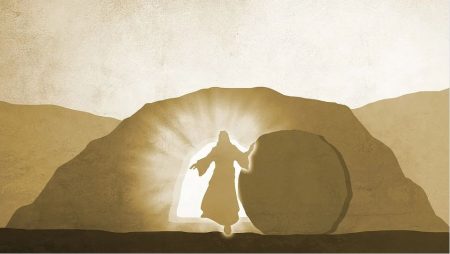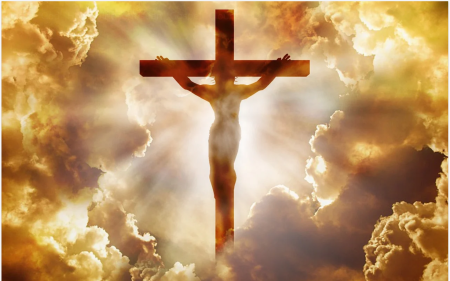by ProfDave, ©2022
(Jan. 7, 2022) — [Editor’s Note: See Parts I and II of this series here and here.]
Into the intractable conflict between what is and what ought to be, the right will of the Creator and the wrong will and performance of mankind, comes the incarnation of the Creator in Jesus of Nazareth, reconciling the world to Himself. That’s a mouthful. It is what Christians believe. To explain Christianity exhaustively is beyond our purpose here. Read the New Testament in the light of the Old. But three aspects apply to the human moral dilemma and to a Christian worldview: who Jesus was, what he said and what he did.
Who was Jesus? On trial for his life before the Jewish supreme court he pled guilty to being both Messiah and Son of God – and we crucified him for it. Then the Almighty turned around and raised him from the dead, validating his claim to be the second person of the Trinity. If the Christian idea that God is three persons in one being strains your brain, remember that God is not a big man upstairs with a white beard – as on the ceiling of the Sistine Chapel. Our small minds cannot expect to understand His structure beyond what He chooses to reveal. He is an infinite spiritual being. We are finite spiritual beings, bearing His image to a finite extent, encapsulated in physical forms. God, as revealed to the Hebrews and in Christ is One. There is only One God, Elohim. The Father is God, the Son is God and the Holy Spirit is God. Jesus claimed to be One with the Father and filled with the Holy Spirit. The rest we will leave with the theologians – lest we stray into heresy. The point is, if Jesus of Nazareth is Christ, the second person of the Trinity, we had better pay attention to what he said and did.
What did Jesus say? His teachings rest on the basic revelation of JHWH in the Hebrew Bible but come as a bursting new wine into the Judaism of his day – and ours. Truthfully, they confront Islam, much of Christianity and all other systems of morality in that day and this. It seems we have it all wrong! God is not a cosmic traffic cop with a whistle in his mouth. The Creator is not an oriental potentate: He is our Father! His nature is holy love. His law is not arbitrary or punitive, but a revelation of His nature and ours, given to us for nothing but our higher good.
Secondly, righteousness and morality must be internal, not just external, based on love, not pride. In the end it is God’s righteousness, not ours, that counts. The Covenant of Sinai boils down to two basic commands: “Thou shalt love the Lord your God with all your heart and with all your soul and with all your mind and with all your strength” and “your neighbor as yourself.” If we do not love God and our fellow mankind, keeping all the rules doesn’t mean a thing. If we try, two things happen: we become self-righteous and we fail. On the other hand, if we actively love God and mankind with all that is in us, rightness comes a lot easier – “it is God who works within you to will and to do what pleases Him.”
In his “Sermon on the Mount” Jesus gave several illustrations of what internal morality looks like. It looks like poverty, mourning, meekness, hunger and thirst, mercy, purity of heart, peacemaking and being persecuted for it all – not riches, pride and glory. We break the law in our hearts when we hate, we lust, we divorce, we need to take oaths, we need to be seen being religious and when we worry. There is more. Read Matthew 5-7. Morality is not an outward show, not an achievement to be proud of, but a humble but all-consuming love that begins deep within, implanted and nurtured by a God who is love, and oozes out into our character, our behavior and our world.
What did Jesus do? Christians believe that Jesus was God in the flesh, completely God and completely human. When he spoke it was God speaking. When he acted it was God acting. When he suffered it was God suffering. When he died it was God dying, and when he rose again it was God rising. How is that possible? We do not know. On the other hand, when he spoke it was a human speaking with a human voice in human language. When he acted it was a human acting – in the power of the Holy Spirit – with human hands and feet. He died a human death and was raised in a human body, though resurrected, and sits on the throne of the Almighty in that resurrected human body. How is that possible? We do not know, but that is a defining teaching of Christianity. If your spiritual leader does not teach so he/she is not fully Christian.
The life of Jesus is a picture of what God is like. He was not just a moral teacher, but a moral liver. He defied his enemies to find any sin in him. He modeled love and compassion. He used the power of the Spirit to do the work of the Father in healing, exorcising and raising the dead. He spoke truth to power and mercy to sinners (!). Outcasts and children were drawn to him while the self-righteous hated him.
The perfect life of Jesus showed what mankind should be in unfaltering harmony with God, love for mankind and obedience to the Father “unto death, even the death of the cross.” It was in that death that the Gordian knot of love, justice and human rebellion was cut. “God was in Christ reconciling the world to Himself.” Or perhaps we should say, He tied the knot of the moral universe and human autonomy – Sinai and Eden. Moral autonomy gives mankind the opportunity to rebel, God in Christ himself undertook to bring us rebels back to harmony in freedom. So much more could be said.
On the cross was demonstrated the ultimate evil, ultimate love and ultimate justice. You and I can be forgiven from the cross, reconciled to God and the moral universe still remain intact. God is consistent. Right is still right and wrong is still wrong. Evil is not excused, but the way back is open to us. But can we take it?
What does this mean for a Christian morality and worldview? What is right and wrong is forever fixed in eternity (Sinai). The human condition is broken – we are endemically prone to do the wrong thing (Eden). Christ, however, flips the equation. Through His sacrifice and forgiveness being right with God means not perfection, but progress – not achievement but direction. In embracing Him, we are born again. Through His resurrection we are resurrected to a new moral life – a fresh start. His resurrection power makes real growth in purity of heart possible. We can do what is right and resist temptation in His power.
So, how do Christians know right from wrong? First, we know right and wrong are objective, not subjective matters — based not on our desires, or our circumstances or status, but on the character of our Creator. Subjective or “situation ethics” only leaves us helpless before temptation — our own selfishness and unguarded impulses — and without any real direction at all. True, a lot of life is lived in the gray, where right and wrong do not directly apply or where demands are contradictory, but we can, if we will, find the gross boundaries. Second, Christian morality is based, not on their compliance with moral law, but on love for the moral law Giver and for mankind. As Jesus said, “If you love me, keep my commandments.” We find as we grow in love the boundaries become less and less difficult to keep. And the more we love Him, the more His love empowers us. Our righteousness — His righteousness, really — “exceeds that of the scribes and the pharisees” without much trouble at all. That is the Christian worldview answer to the morality question.
David W. Heughins (“ProfDave”) is Adjunct Professor of History at Nazarene Bible College. He holds a BA from Eastern Nazarene College and a PhD in history from the University of Minnesota. He is the author of Holiness in 12 Steps (2020). He is a Vietnam veteran and is retired, living with his daughter and three grandchildren in Connecticut.




Wonderful explanation . Thank you.